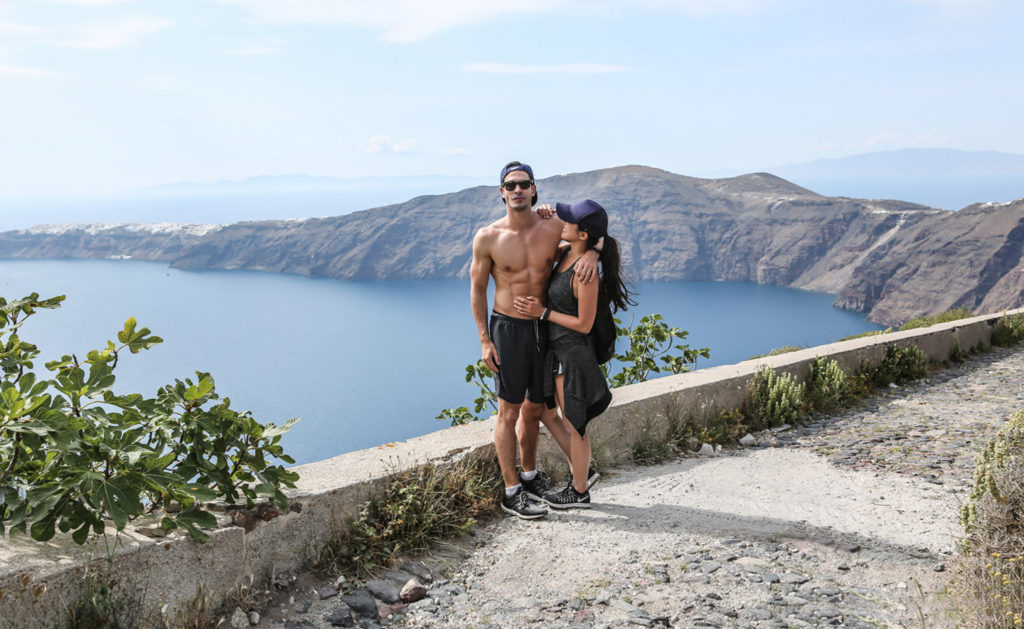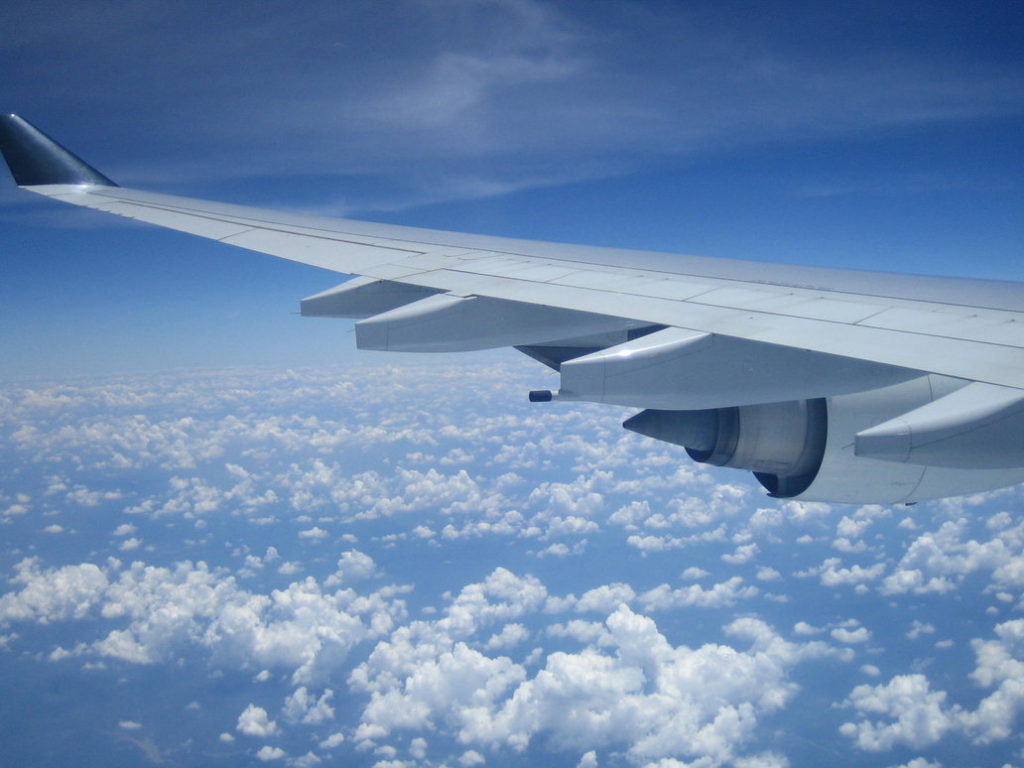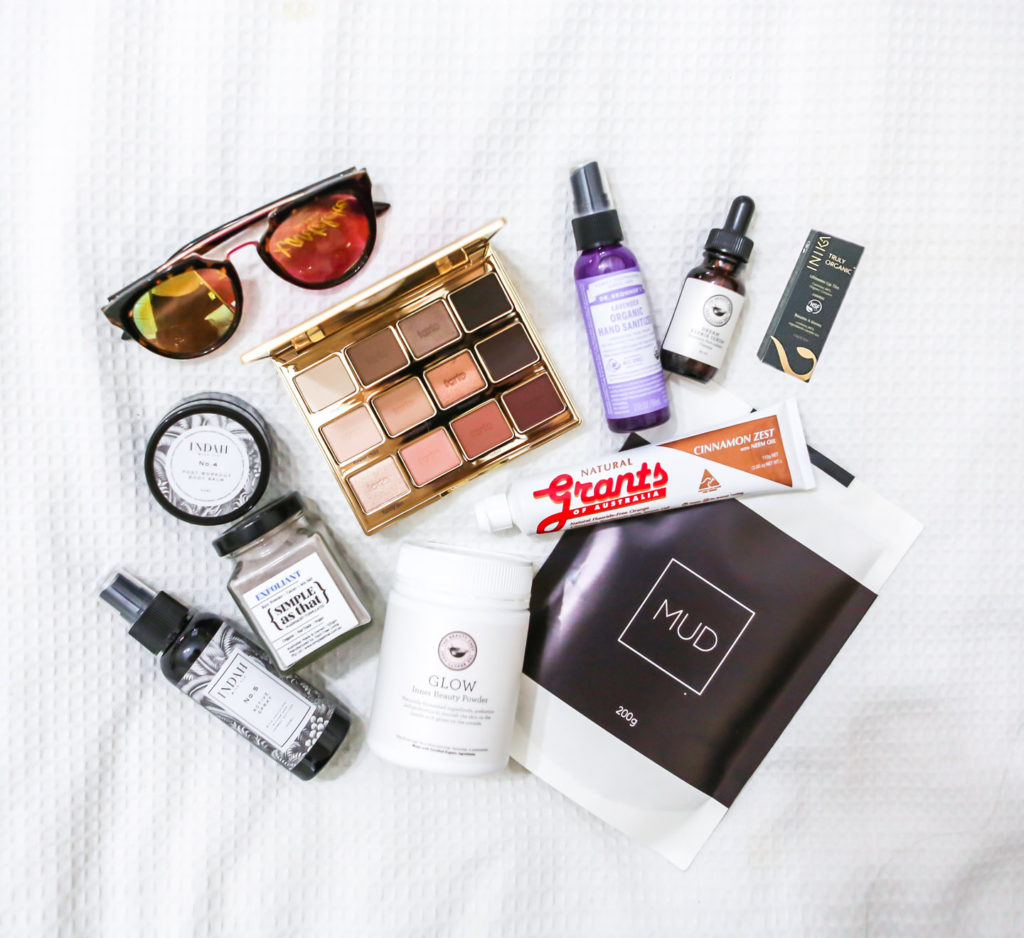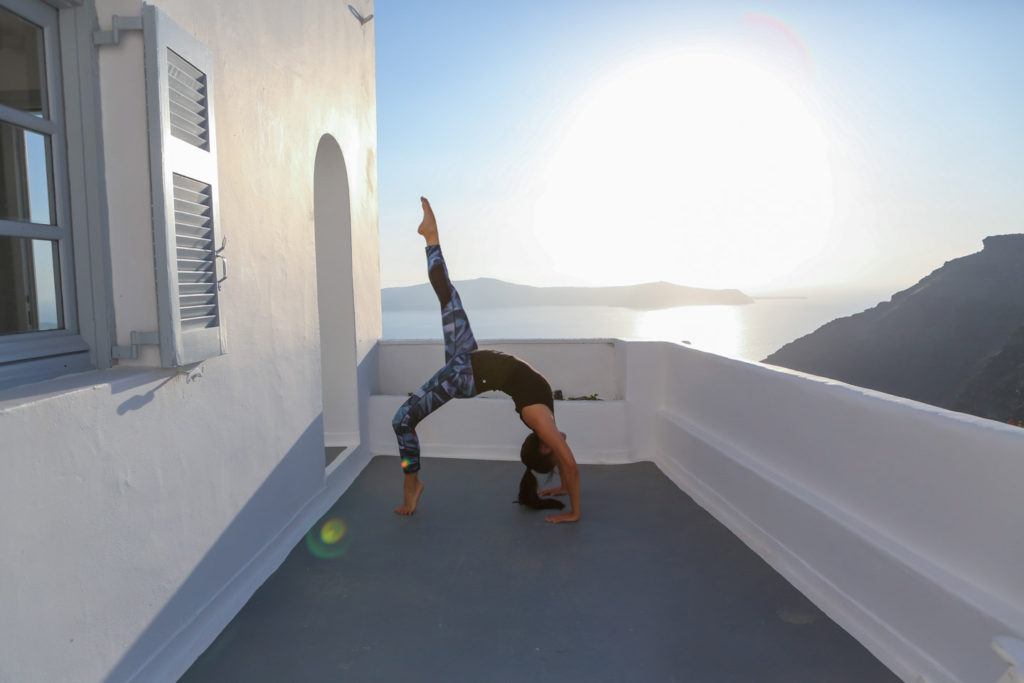My non-negotiables from years of wanderlusting
+++++++++++++++++++++
Obligatory travel snap from Santorini… Take me back!
+++++++++++++++++++++
Our insatiable wanderlust has ensured that Nic and I are very well seasoned travellers. We’ve covered everything from slothful luxury beach escapes to hanging-off-Himalayan-mountains-in-three-week-old-outfit adventures allowing us to become very aware of the kind of travellers we each are and the little travel habits we have developed accordingly. Our recent trip was more varied than usual (with a mix of resort life, workation, wedding, time-zone-traversing, pitstop home then yoga retreat-ing), but I noticed a few habits that stay the same no matter what. Thought I’d commit them to writing to keep one foot in the travel door and avoid the post-adventure come down! If you’re travelling soon, VERY JEALOUS! Hopefully some of these are helpful!
1. Sound and light control – eye masks and ear plugs
One of the things I have come to value the most when travelling is the ability to control my environment as much as possible, particularly during transit itself. Sound and light have an especially profound impact on your system. I’ve finally worked out what my body needs to best adjust to new timezones quickly and how important being able to manipulate sound and light can be. The main reason for this is the impact it has on my sleep.
Sleep is increasingly important to me – partly as I squeeze more into my days and partly as my teenage ability to bounce back after an all nighter has gone MIA. Especially after reading Ariana Huffington’s The Sleep Revolution, I’ve also focused more on sleep quality – I used to wonder why I could sleep a solid 8 hours but wake up feeling entirely unrested. The many devices we all have in our rooms these days aren’t don’t help by emitting disruptive light and interrupting our REM cycles. So even before our recent trip, I dug up a few unopened airline eye masks to give them a crack – I’ve never looked back.
It is already challenging in our own homes, but travelling makes light control even harder (especially if your prep includes altering sleeping patterns before you leave). But an eye mask blocks out all light (and the world) any time and flicks your brain into “sleep mode” which is vital in transit when the light and your body clock often aren’t in sync. Once you get used to the sensation, you realise the true value of this simple invention. Same goes for ear plugs (or the fancier version, noise-cancelling headphones. I used to think they were disproportionately expensive but I borrowed Nic’s recently and they changed my LIFE. They block out EVERYTHING.) These two things have proved essential for me when travelling and they come with me everywhere we go!
2. Insane in the plane
For some people, long stretches of time on an airplane = insanity. For me, I absolutely SAVOUR being in “airplane limbo” – you can’t do anything other than be where you are and either sleep, read, eat or watch TV. For an over-active busy bee, that forced inactivity is quite liberating! BUT it can become quite uncomfortable and hard on the body, especially on long haul flights. So a few of my plane survival tips (other than ear plugs and eye masks) are:
- Hydrate – This is the key to all my other points, but is also important in itself. Hydrating on planes is easy to forget (and often hard to do, as you have to pester the hostesses). It helps keep your skin from drying out and maintains mucous levels to flush out germs and avoid getting sick. So as soon as I’m through security I always buy my own water.
- Move around – I started with hydration because the flow on effects include forced movement i.e. when nature calls. We’ve all seen the DVT warnings – you need to keep moving!!! I do a few stretches too every time I get up to give my body a break – you can really feel the difference when you land from moving regularly rather than staying still.
- Get an aisle seat – I always get an aisle seat so I don’t have to bother anyone and can move around as I like (which is quite frequent given the above points). Bonus tip – check in online ALWAYS so you can choose your seat, avoid seats up the back of the plane and snatch up baggage space before it fills up. Plus check in queues are always shorter!
- Snacks – Most airlines are improving at accommodating dietary requirements but this hungry hippo finds the serving sizes small. Plus a few airlines still haven’t quite caught up, so I like to BYO snacks just in case. At least know you’ve got something to keep you going that won’t send you into a bloated, foetal-position mess halfway through a flight. Plus if you buy them before you leave, you won’t get stuck with over inflated airport prices for things you can get way cheaper elsewhere.
Image credit: Google
3. Jetlag management
This is different for everyone, so my method may not be helpful to you. I’ve tried most techniques and my best lesson has simply been to stop trying so hard! I used to start changing my eating and sleeping a few days before, but found that just prolongs the confusion to the body. Now, instead of calculating what time it is where I came from and where I’m going, I just treat the whole flight part as “plane limbo”. Since it’s hard to sleep on planes as it is, my first rule is to sleep as much as possible (no matter when it is) because whatever you get is a bonus (see dot point 1). I eat when they feed me because you don’t get much choice and the plane meals are usually timed to help you move into your target timezone anyway. If I can’t sleep, then that’s when I’ll watch or read something. Then as soon as I land, I just mentally adopt that timezone as if it’s been that way all along.
You’re going to be tired either way so don’t overthink it – the time is the time in the place that you are so assimilate to that mentally as soon as you can and your body will catch up. Be patient with yourself though while your body figures itself out. There are a few gentle things that can help like lavender oil to help you sleep too (or stronger medications if you wish).
4. Be a walking pharmacy
I am known as “Mary Poppins” among friends I’ve travelled with, because I come equipped for all situations (especially medical). You can generally buy most medications and toiletries in most places, but sometimes the brand that you know works for you isn’t available or, more awkwardly, you don’t have the energy/ability to leave your accommodation at all. So I am always a bit of a walking pharmacy – especially after travel in India and Africa, you appreciate having a full arsenal of tummy bug drugs on hand when you need them! And if you’re going somewhere where English isn’t widely spoken, sometimes it’s a battle just to explain what you want, so I just ensure I have it all already.
A few of my must-haves are Enos to settle an overwhelmed tummy, GastroStop and the like for the more major tummy upsets, Hydralyte to rehydrate after major tummy upsets (see the common theme here?), some antihistamines, painkillers, disinfectants, cranberry tablets (ladies, you know why), broad spectrum antibiotics (just in case the cranberry tablets aren’t enough), herbal sleeping tablets and a multivitamin.
A few things I took this time around…
5. Put your precious things in carry on baggage
Particularly following on from the above, I’ve been caught a few times being VERY prepared for the situation at hand but not anticipating that it would happen before I arrived. When things are in your checked baggage, but you’re still on the plane, they’re not much use to you! So with medications but also any valuables that are absolutely indispensable where you’re going, carry them all in my hand luggage so baggage delays or mishaps aren’t dire.
6. Data and devices
Like most of the list, this sounds obvious but I almost forgot last time! Many phone providers now have international roaming data plans that allow you to use 3G internet overseas at a capped rate, but you have to activate before you leave. Research the best options before you go and if it’s a particularly long trip, it might actually be worth just buying a local sim when you arrive. Another tip is to do a manual back up of all your devices before you leave – we all keep such treasures on our devices, it’s so crucial to have another copy somewhere because phones and computers are prime candidates for theft or loss. We back everything up on a 1TB hard drive before we go anywhere (and every few weeks generally).
7. Research in advance
- For context – This used to be so obvious, but as life has become busier I have tended to continue “business as usual” right up until rushing onto the plane. Gone are the days where reading long texts about our destination before leaving seems like a reasonable use of time, but I think we’ve swung too far the other way and have turned up at a few places without any background. It’s a shame to experience something without the full context to be able to appreciate its significance. So I’ve made a commitment to making time for at least a quick background read on my destination and the key places we’re visiting.
- For eating – Also because I’m a devout foodie who could cry over a bad food experience (plus add dietary intolerances to the mix), our pre-trip research invariably involves lots of restaurant/cafe/wholefoods market scouting. We always research the local cuisine and best places to try it plus keep an eye out for health foodie joints that are gluten-intolerance friendly. I also always scope out places with health foodie friendly snacks (even just the supermarket) for those times when you just need a snack or don’t want to eat out. We like to spontaneous in terms of what we do but where we eat is sacred!
- For exercise – Like food planning, this obviously only applies if you’re an enthusiast (which Nic and I both are). If your accommodation has facilities, that’s great. You might even choose your accommodation on that basis. But if not, it always helps to look up local places that have casual passes or other outdoor fitness hikes/treks/activities that could serve as an alternative. If it’s looking like slim pickings, we’ll often travel with lightweight portable equipment (i.e. Therabands) to use on the go and find HIIT/yoga/etc DIY YouTube videos to do in our hotel room if we’re feeling a bit sluggish from all the feasting.
Grecian balcony yoga!
8. Digital detox
This last trip in particular, I’ve really started to incorporate a “digital detox” element into our travels. Particularly since starting an e-commerce business, we both find it VERY difficult to switch off our devices (and therefore our minds). But part of the point of a holiday is to let your brain unwind and fully enjoy the place you’re exploring. The other temptation is to take photos of EVERYTHING and I am one of the worst culprits. This just ensures you’re still on your device even if you’re “not working”. But this time, I made a big effort to set up systems and delegate work in a way that allowed us to limit our device time to 1 hour per day. It was positively life changing! For photos, we used our cameras (but if we took our phones, it was airplane mode only). Obviously, digital detoxing is not permanently sustainable in what we do, but short bouts of it did us a world of good. Watching the sunrise NOT through a screen?! Shouldn’t be revolutionary, but it was! Not everything needs to be committed to a photo. Sometimes the memory bank is good enough.
9. Dear Diary…
Part of being off our computers meant that my travel diary (which I always keep) was handwritten. I very rarely handwrite now, but loved it because it meant actually thinking and reflecting on what we did each day. Retraining my mind to remember things not through photos but through actually experiencing them and not waffling on forever because my hand can’t write as fast as my hands can type was very refreshing. It’s sounds so old school but I LOVE going back through my old travel diaries. Even by the time you leave, if you go back to the first day of your trip there’ll be something you wrote down that you’d already forgotten. It’s not so much the big things that I love going over, but the smaller insignificant details that are so endearing and happy at the time but you wouldn’t otherwise remember. Try it, even if it’s only dot points. It’s such a nice way to bring a part of your trip home.
10. YOLO – Money is replaceable, time is not.
Finally, my favourite tip is that sometimes you just gotta break the budget. I mean, of course, be sensible. We all have budgets and they exist for a reason. But sometimes you can get a bit too rigid for the sake of sticking within it at the expense of a wonderful spontaneous adventure or experience. Once upon a time I would have half-slept on an airport floor all night to save a night’s accommodation. As you get older though, you realise time is finite but money can be remade. Comfort actually matters to me now, as does good sleep and living life to the fullest. You generally don’t regret spending the money but you regret missing out on something amazing.
We were recently in Dubai for a 10 hour layover and were going to just pass the time from midnight to 10am wandering around and resting on airport chairs… but the minute we landed, we knew our bodies were tired (it was the end of our trip), we didn’t have 10 hours worth of energy for duty free window shopping and sleeping in contorted positions, so we went straight to the airport hotel and booked in for a solid 8 hour sleep on a proper bed. Best money we’ve ever spent. Of course, we are lucky to have the luxury of making those choices and not everyone can. BUT we work and save very hard for our holidays and travel modestly – we’ll only splash out on special occasions or in times of need (such as sleep-deprived mid-transit zombie Dubai stopovers). So yes, my last tip for travel and for life generally is YOLO – cliche as it is, truer words have never been said!
+++++++++++++++++++++
Happy travels!!




